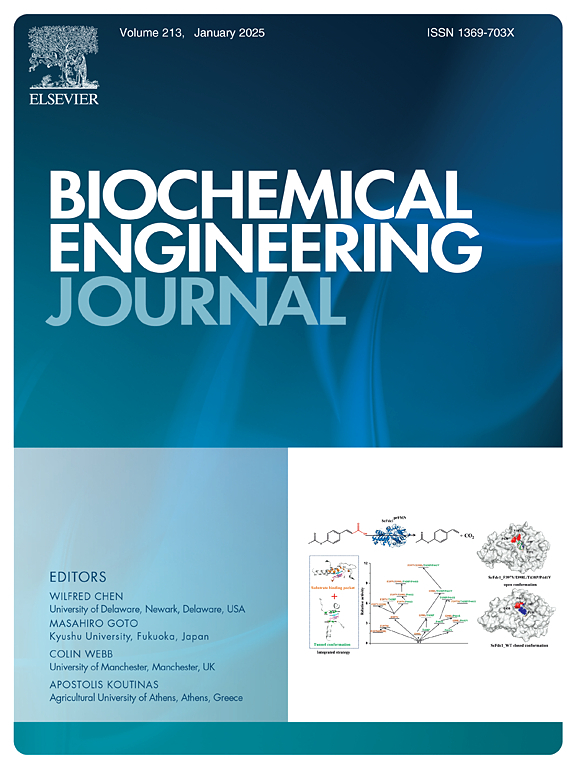整合热带念珠菌和 Pichia kudriavzevii 降解偶氮染料和积累脂质的方法,以及对潜在代谢组学的深入了解,以处理纺织污水
IF 3.7
3区 生物学
Q2 BIOTECHNOLOGY & APPLIED MICROBIOLOGY
引用次数: 0
摘要
各行各业广泛使用的偶氮化合物会释放出对环境和人类健康有害的有毒废水。传统的偶氮染料去除方法往往会产生有害的副产品或浓缩污泥,使处理工作变得更加复杂。本研究探讨了热带念珠菌和 Pichia kudriavzevii 这两种酵母菌株在积累脂质的同时有效脱色偶氮染料(TD4、TD5 和 TD6)的潜力。在培养过程中,这些培养物对所选染料的脱色率达到 80-90%,与念珠菌相比,Pichia 对多种染料的脱色效率更高。脂质分析确定了有价值的脂肪酸,如棕榈酸和油酸,它们在生物燃料和其他行业具有潜在的应用价值。总有机碳 (TOC) 分析显示 TOC 有所减少,表明酵母菌对染料进行了降解和矿化。通过液相色谱-质谱(LC-MS)进行的代谢分析证实了降解,显示在添加染料的培养物中存在唑类、偶氮啉类、异喹啉类、吡啶类和苯并吡喃类等中间产物。此外,与能量代谢、氨基酸代谢、药物代谢(细胞色素 P450)、芳香族化合物降解和类固醇生物合成有关的途径也在染料处理的培养物中得到了丰富。在有染料存在的情况下,脂质产量从 40% 到 90% 不等。因此,该研究证明了经济上可行的脂质生产与高效染料去除相结合的概念,为环境和工业挑战提供了一种可持续的解决方案。本文章由计算机程序翻译,如有差异,请以英文原文为准。
Integrating azo dye degradation and lipid accumulation by Candida tropicalis and Pichia kudriavzevii along with insights into underlying metabolomics for treatment of textile effluents
Azo compounds, extensively utilized across various industries, contribute to the release of toxic effluents that are detrimental to both the environment and human health. Traditional methods for azo dye removal often result in harmful byproducts or concentrated sludge, complicating disposal efforts. This study explores the potential of two yeast strains, Candida tropicalis and Pichia kudriavzevii, to effectively decolorize azo dyes (TD4, TD5, and TD6) while simultaneously accumulating lipids. The cultures achieved 80–90 % decolorization of the selected dyes during incubation, with Pichia showing higher efficiency across multiple dyes compared to Candida. Lipid profiling identified valuable fatty acids, such as palmitic acid and oleic acid, with potential applications in biofuels and other industries. Total Organic Carbon (TOC) analysis revealed a reduction in TOC, indicating degradation and mineralization of the dyes by the yeasts. Metabolic profiling via LC-MS confirmed the degradation, showing the presence of intermediates such as azoles, azolines, isoquinolines, pyridines, and benzopyrans in dye-supplemented cultures. Additionally, pathways related to energy metabolism, amino acid metabolism, drug metabolism (cytochrome P450), degradation of aromatic compounds, and steroid biosynthesis were enriched in the dye-treated cultures. Lipid output in the presence of dyes ranged from 40 % to 90 %. The study thus demonstrates a proof of concept for economically viable lipid production combined with efficient dye removal, presenting a sustainable solution to environmental and industrial challenges.
求助全文
通过发布文献求助,成功后即可免费获取论文全文。
去求助
来源期刊

Biochemical Engineering Journal
工程技术-工程:化工
CiteScore
7.10
自引率
5.10%
发文量
380
审稿时长
34 days
期刊介绍:
The Biochemical Engineering Journal aims to promote progress in the crucial chemical engineering aspects of the development of biological processes associated with everything from raw materials preparation to product recovery relevant to industries as diverse as medical/healthcare, industrial biotechnology, and environmental biotechnology.
The Journal welcomes full length original research papers, short communications, and review papers* in the following research fields:
Biocatalysis (enzyme or microbial) and biotransformations, including immobilized biocatalyst preparation and kinetics
Biosensors and Biodevices including biofabrication and novel fuel cell development
Bioseparations including scale-up and protein refolding/renaturation
Environmental Bioengineering including bioconversion, bioremediation, and microbial fuel cells
Bioreactor Systems including characterization, optimization and scale-up
Bioresources and Biorefinery Engineering including biomass conversion, biofuels, bioenergy, and optimization
Industrial Biotechnology including specialty chemicals, platform chemicals and neutraceuticals
Biomaterials and Tissue Engineering including bioartificial organs, cell encapsulation, and controlled release
Cell Culture Engineering (plant, animal or insect cells) including viral vectors, monoclonal antibodies, recombinant proteins, vaccines, and secondary metabolites
Cell Therapies and Stem Cells including pluripotent, mesenchymal and hematopoietic stem cells; immunotherapies; tissue-specific differentiation; and cryopreservation
Metabolic Engineering, Systems and Synthetic Biology including OMICS, bioinformatics, in silico biology, and metabolic flux analysis
Protein Engineering including enzyme engineering and directed evolution.
 求助内容:
求助内容: 应助结果提醒方式:
应助结果提醒方式:


